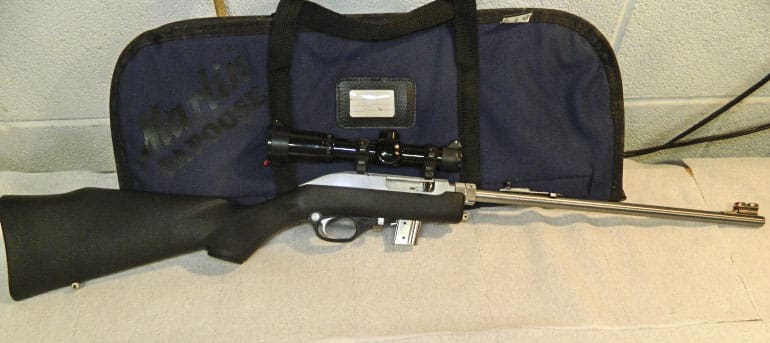
When Ruger introduced its takedown version of the 10/22 back in 2012, the world (or at least the gun-centric parts of the internet) went wild. Prior to that, by far the best-known example of a takedown, semi-automatic .22LR rifle was the AR-7 (currently produced by Henry, though it’s been made by a number of manufacturers over the years).
So it seems that the Marlin Model 70PSS (Take Down)—lovingly and unofficially nicknamed the “Papoose”—though certainly not unknown, is something of the neglected middle child of this class of rifle. That’s a sad state of affairs because while the 70PSS isn’t the most compact or the most versatile takedown .22, it nevertheless has a lot to offer.
Overview
First introduced in 1986, the Papoose is a takedown version of Marlin’s Model 70 (now sold as the Marlin 795), itself a detachable-magazine variant of their classic Model 60 semi-auto.
As introduced, the original 70P model of the Papoose was made of blued steel and had a wood stock—traditional, but perhaps less than ideal for a gun meant to potentially be used as a survival rifle. The current production 70PSS variant, rather more appropriately for a rifle of this type, instead features highly weather-resistant construction.
Aside from the aluminum receiver, the gun is made entirely of stainless steel, with some components, such as the bolt, sling swivel studs, and magazine, being nickel-plated for extra corrosion resistance. The gun features a black fiberglass-filled synthetic stock.
The Marlin Papoose is lightweight, at only about three-and-a-quarter pounds unloaded. When assembled, the 70PSS is just over 35 inches long with its 16.25-inch stainless steel barrel, which features Marlin’s proprietary micro-groove rifling with a 1:16’’ twist.
Size-wise, this puts it right about on par with the AR-7, and almost a pound-and-a-half lighter and two inches shorter than the 10/22 Takedown—although admittedly the Ruger’s extra length seems to come entirely from its slightly longer barrel.
The Papoose’s Monte Carlo-style stock features a very reasonable 13.25-inch length of pull, which seems almost long compared to the rifle’s generally svelte dimensions and allows larger shooters to use the rifle comfortably. The stock possesses no real forend, ending abruptly only about two inches past the magazine well.
Fit and finish are generally excellent. The stock is well molded, with barely-visible seams, and no flashing. The synthetic material has a nice texture: rough enough to provide a good grip, but not so rough as to be abrasive in any way. The stock also features simple molded-in checkering on the butt plate and the sides of the grip, for additional traction.
The metal components show no obvious tool marks. The aluminum receiver features a brushed finish, while the steel parts are all well polished—though, unfortunately, the two sheens don’t quite match up.
All in all, while the Papoose might never be called sexy, it’s very well made, and far from ugly—managing to neatly straddle the line between utilitarian and adorable.

The Papoose features a pretty good set of iron sights, consisting of a hooded ramp front sight, and a wide, shallow rear notch—not precision target sights, but plenty good for a rifle of this type. The front sight blade is a high visibility protected orange post, made of a day-glo orange plastic which is probably bright enough to be seen from space.
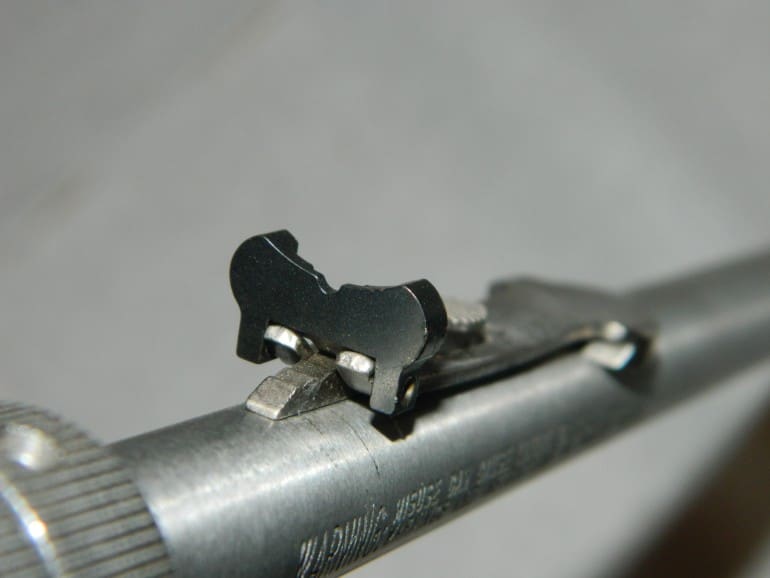
The rear sight is adjustable for elevation, and drift adjustable for windage. Both the front and rear sights are mounted directly to the barrel, which should prevent any loss of zero when the rifle is disassembled and reassembled.
In addition, the top of the receiver is grooved to allow for the mounting of a scope, or other sight; mine wears an old 4x Burris Compact. While mounting an optic to the Papoose theoretically negates the guaranteed repeatability of having the sights fixed to the barrel, as you’ll see in the shooting section below, for my rifle at least, it wasn’t an issue.

The rifle’s controls are simple, and well laid-out. The cross-bolt safety is located at the back of the trigger guard, and the magazine release takes the form of a lever just behind the magazine well. Pull it back and the mag will drop free as long as the bolt’s open (and as long as you’re careful to keep your fingers out of the way).
In addition, unlike most semi-auto .22 rifles, the Papoose features not only a last-shot bolt hold-open, but also a manual bolt hold-open/bolt release lever; push it up to lock, pull it down to release.
The manual bolt release, I should mention, is the only way to close the bolt after reloading—pulling on the charging handle doesn’t do anything. Thankfully, the release is quite easy to trip with your trigger finger (for righties, anyway).
The rifle’s trigger pull is on the heavy side, but fairly crisp, with only the slightest amount of take-up before the break.
The Papoose comes with a single 7-round magazine, made of stainless steel. Additional magazines are readily available, as are 10-rounders. ProMag even makes a 25-round magazine for the gun, though I haven’t tried one and reviews seem somewhat mixed, so caveat emptor.
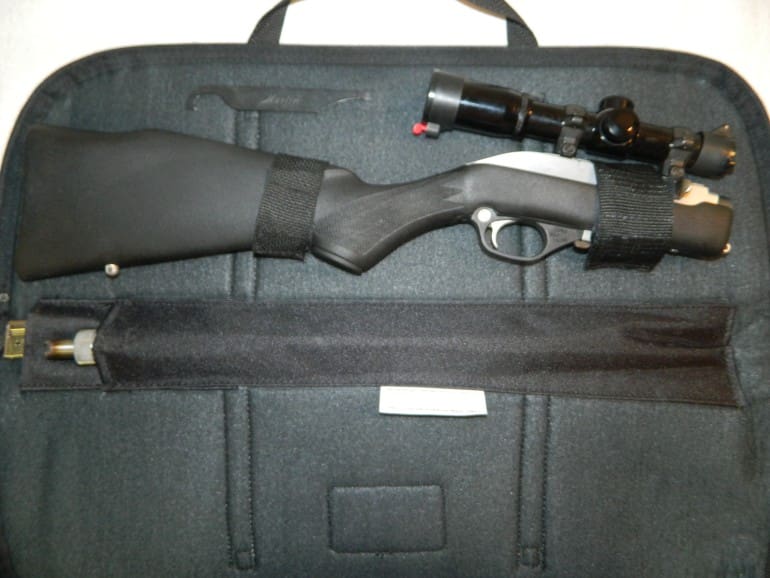
Of course, the most important feature of a takedown rifle is its ability to, well, be taken down. Thankfully, disassembling the Papoose for storage or transport couldn’t be easier. Simply lock open the bolt, unscrew the barrel nut, and pull the barrel straight out of the front of the receiver.
Reverse this procedure to reassemble it. The rifle comes with a simple wrench to aid in loosening or tightening the barrel nut, but the nut is also slotted to allow you to use something like a coin instead.
Taken down, the Papoose easily fits into the included soft carry case even with a (reasonably compact) scope attached. This results in a handy package which is a mere 24.5 inches long by 8.5 inches wide, and only 2.5 inches thick. It can easily be stowed in a backpack, underneath a car seat, or pretty much anywhere, really.
The case is lined with closed-cell foam to supposedly enable it to float with the rifle inside, though I haven’t tested this feature.
On the Range
As you’d expect, the Papoose is a fun gun to shoot. While not a target rifle by any means, it does have good accuracy potential, though wresting that potential out of it is a somewhat difficult proposition.
On the range, the Papoose’s lilliputian size and feather-light weight that make it so eminently transportable unquestionably also make it somewhat more difficult to shoot well than a normal-sized rifle.
Its lack of a real forend, in particular, makes shooting a bit awkward, as it leaves you with no real hold option other than to cup your support hand around the front of the gun just below the barrel nut. That isn’t exactly the steadiest grip.
The rifle’s light weight tends to make the gun more susceptible to wind or even the slightest twitch of your body, which is exacerbated further by its somewhat heavy trigger pull.
Still, when testing a rifle like this, one has to remember the fact that it’s a bit of a specialized tool, optimized more for portability than accuracy. One doesn’t usually expect a takedown survival rifle to be a tack-driver. That wouldn’t be realistic.
With that in mind, accuracy testing was done at 50 yards from a simple standing rest position, firing 5-shot groups and discounting the occasional obvious flyers, most if not all of which were probably my fault.
Reliability of the rifle was perfect. Armscor high-velocity hollow-points, CCI Stingers, Remington Vipers, Winchester Wildcats—the Marlin 70PSS flawlessly fed, fired, and ejected everything it was given.
And despite what I said above about the gun’s design limiting its practical accuracy, the very first group I shot, using the Armscor ammo, demonstrated that the potential is definitely there.
Intended only to check that the scope was sighted-in properly (as it turned out, it wasn’t) and to re-acquaint myself with the rifle since I hadn’t fired it in a long time, this group ended up measuring a mere 0.56 inches across. This was definitely an anomalous result—the single best group of the day by far.
Even so, though I never matched that feat again during the rest of the session, the Papoose still made a good showing, given its intended use.

With subsequent groups, the Armscor ammo averaged out to 1.46’’, with the smallest group after the first one being an even 1.0 inch (not counting one flyer).
I had never tried this ammo before, and was rather impressed to find that it led the pack in accuracy, even if only by a slim margin.
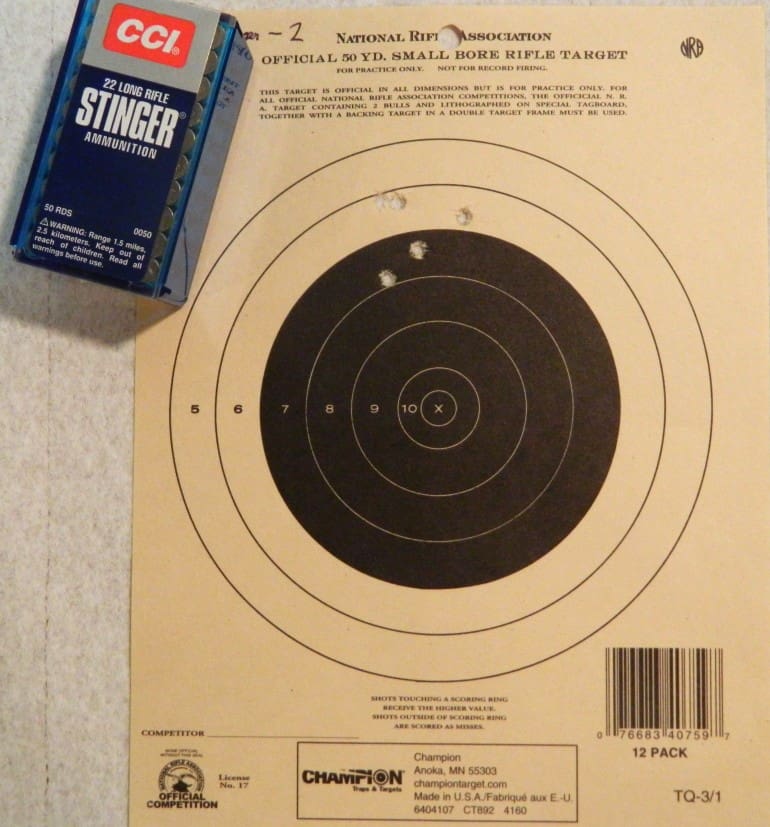
The CCI Stingers had the most variation in group sizes, but still averaged a respectable 1.58’’ with the smallest group being 1.06 inch.

The Remington Vipers likewise averaged 1.58’’, but were more consistent, with the smallest group being 1.50 inches.
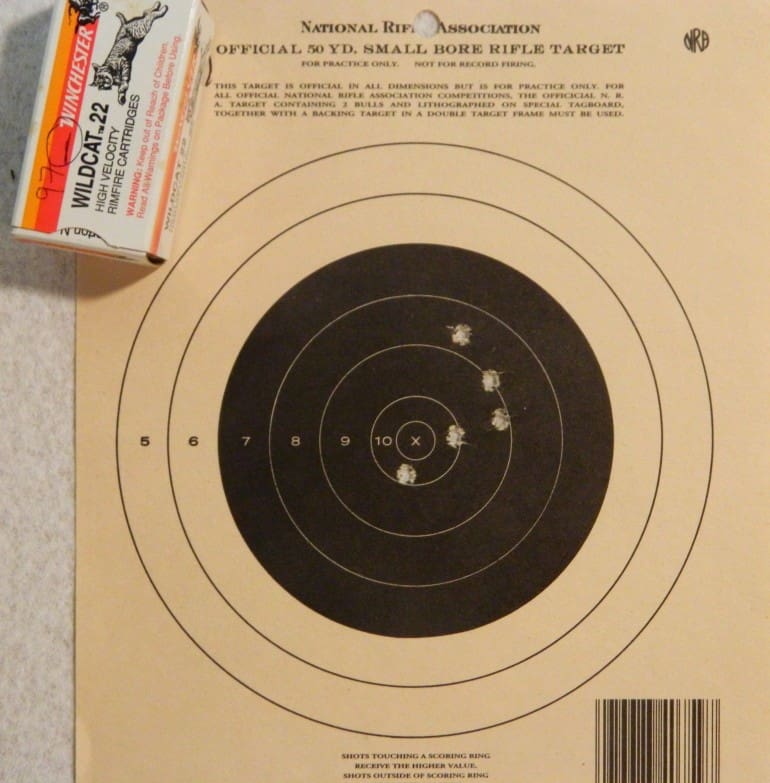
The Winchester Wildcat ammo gave an average group size of 1.85’’ with the smallest group shot being 1.25 inch.

The last thing I did at the range was to quickly check and see if there was any clear shift in point of impact when disassembling and reassembling the rifle while using a scope. I fired one group, removed the barrel, waited a minute before reattaching it, and then fired a second group.
As you can see from the target above, the point of impact most certainly did not change—the second group is centered in exactly the same place as the first group (circled in blue).
Of course, the second group is also much larger than the first, which I can’t entirely explain (the barrel nut was tightened the same amount before and after), but it was probably my fault rather than the gun’s, given that it was the last group of the day and I was getting tired in the heat.
Survival rifles like this are always compromises. But even with its difficulties, the Papoose’s practical accuracy is more than sufficient for its intended purpose of shooting small game at modest ranges. And with more practice, or in the hands of a more capable shooter, I’m certain the rifle can do far better than I managed with it.
Conclusion
The Marlin 70PSS Papoose’s curse seems to be one of intermediacy. The AR-7 is slightly more portable, pulling a neat Russian nesting-doll trick by packing away inside its own stock. It’s also more famous for having once been featured in a James Bond movie.
The 10/22 Takedown gets to build on the popularity and immense aftermarket support of its borderline-ubiquitous standard model—a gun so well-loved by its fans that to this day you’ll still find the occasional person online holding it up as the perfect example of a “do-everything” rifle.
The 70PSS is thus left in a bit of a gray area. It’s not quite as compactible as the AR-7, but (IMO) more nicely built and laid-out. And smaller and lighter than the 10/22 Takedown, but by that virtue a little more specialized towards portability, and hence not as well suited for more general-purpose use, such as plinking.
Even the Marlin 70PSS price is middle-of-the-road, falling roughly halfway between that of the basic black AR-7 model on the low end and the basic 10/22 Takedown on the high end (although the Papoose’s MSRP is actually a tiny bit lower than that of the “fancier” camo models of the AR-7).
Still, while it might not lead the field in any particular category (with the exception of its having a manual bolt hold-open/release), the Marlin 70PSS Papoose is nevertheless a fantastic rifle, providing good accuracy in a small, exceptionally reliable, reasonably priced package.
Whether you’re looking for a survival rifle in case your plane goes down in the wilderness, or just a light and compact gun for backpacking, canoeing, or any other outdoor activity where space and weight are at a premium, if you’re in the market for a takedown .22LR rifle, the Papoose definitely deserves a look.
Specifications: Marlin 70PSS (Take Down)
Caliber: .22 Long Rifle
Capacity: 7 rounds
Barrel Length: 16.25 inches
Weight: ~3.25 lbs. (empty)
Sights: Hooded, ramp front sight; adjustable open rear sight. Receiver grooved for scope mount.
MSRP: $352 (about $273 at Brownells)
Ratings (out of five stars):
Accuracy: * * * *
Quite good for a rifle its size. Although making the most of that accuracy requires a steady hand, and probably more practice than I’ve had.
Reliability: * * * * *
Flawless. No problems of any kind.
Ergonomics: * * * *
Nice stock, light and comfortable in the hands, with good placement of the controls. Dinged one star for its lack of a proper forend.
Customize This: * *
A scope and larger magazines pretty much covers it, but there are some other aftermarket parts out there (such as an aluminum keymod handguard) if you really want to get fancy.
Overall: * * * *
Well-built, light, compact, and surprisingly accurate; even in a post-10/22 Takedown world, the 70PSS Papoose very much holds its own.






Nice to see the Papoose is still around
I bought a couple as gifts in the 90s. We were shooting 1.5 inch group with irons (bead front not orange front sight) at 50 yards.
Great rifle for teaching kids to shoot or having in the truck.
Always wished Marlin would develop a stock made to hold 3 or 4 magazine and a storage container for little things. Many folks do this on their own but it is always a little clumsy to get to the stuff.
And Marlin did call it the Papoose in their literature when they brought it out.
Papoose is hardly unofficial. It says “Papoose” right on the case in the first picture. It could be argued that Papoose is just the case, and the rifle is the 70PSS. The gun in the case will float. The AR-7 in its ridiculously thick stock floats too, but not the 10/22.
I bought a 70P decades ago. Fun little gun at first, but I got bored with it eventually when the nifty take-down feature got old.
Not as ugly as the AR7.
Not as pretty as the 10/22.
A firearm that fits no niche that’s not already covered.
I’m sure someone will buy it, but Ruger has the after-market add on parts cornered, and the 10/22 iron sights are better. As is the rotary 10 round mag. with a flush fit.
Sorry my friend, but it does fill an important niche. That niche is “take down rifle for the Marlin fans”. I’d love to have one to go with my Marlin 60, and 795. 10/22s are great, and I’d love to have one of their take down rifles as well. Still, somehow I just favor the Marlins.
BTW, the new Rossi RS22 is also a fun lightweight plinker, and is even lighter and cheaper than the 795.
I’ve got an older wood/blue one. It came with the red bag with Marlin Papoose on the side of it. Found it on Craigslist 13 or 14 years ago for $40. I had the barrel threaded for a silencer and added a little red dot sight. It’s ugly but one of my favorite 22s.
Love my Papoose. Inexpensive ($219). reliable (takes all ammo). accurate. Easy to pack.
If I could purchase one of these locally for $200 even, I would purchase it. I am not willing to shell out $270.
if there are really 10 shot mags available I might look for one of these. I have a m75c that is a good gun and never failed me. only the worst bulk ammo makes it hiccup otherwise it just goes bang with everything else. although I should clean it . I put it away some time ago ( about 30yrs ago) without cleaning it. took it out a little while ago when a friend wanted to go shooting and it just worked. ( and still grouped nicely when I shot it). oh, and the reason why I did not clean it before? it was 1982, and I did not want to be late for the Rocky Horror Picture Show. ( don’t worry I cleaned after this time).
I remember a 20 round “banana mag” my dad had for his in the late 80s. It was dark transparent and had an orange follower and probably bought at Wal-mart. It worked very well, I recall that gun having very few issues. Unfortunately, I do not recall the brand of magazine but mom still has it somewhere.
Pro Mag makes a 25 round mag for the Papoose. Works great.
I’ve had my Papoose for several years now and prefer it to just about every take down .22 I have- the only exception is the Browning SA-22 (and as far as gorgeous .22lr’s go, the SA-22 takes the cake). 25 round magazines are available (sometimes), and $50-70 scope makes the papoose a great meat-getter and probably the lightest rifle I own. I like Papoose MUCH more than the takedown 10/22, which I really only got as a host for the Silent-SR ISB, that I haven’t gotten, and with the way things are going, maybe never will. The pouch for the Papoose is no tactical sling that the 10/22 is in, but then again, if it’s needed for survival, the papoose will fit in another bag, whereas the 10/22’s bag is too small to hold much more than a few hundred rounds of .22, and too big to go into anything that can be reasonably carried.
I once had a dyslexic customer ask for a marlin “poop ass”.
So you sold him him a Chiappa?
Someone should invent a rear sight that looks like a disk with a hole in the center for you to “peep” thru. Then show it to all of the mfg of .22 rifles.
Gear up as your favorite Delsin Rowe Vest. Slim Fit Leather Jackets brings this iconic jacket from animation to reality, especially for all the fans of this video game. Delsin Rowe is the main protagonist and playable character, a young Native-American man who later realizes he’s a Conduit with special powers.